Hidden in Plain Sight: Dying and Homelessness
This is one in a series of articles examining the relationship between housing loss and death in San Francisco. Check out the previous articles in the series, Looking for death, Gunpowder on the streets, and Will losing your home kill you?
In every training program, nationwide, they are the cases you don't easily forget, the ones doctors and nurses and social workers remember years later*:
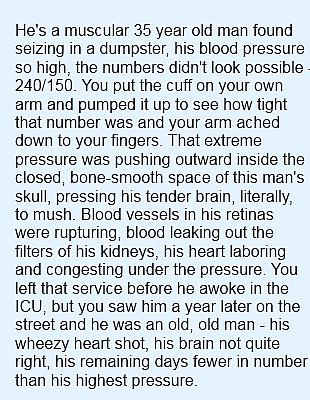
There were the abscesses, the botulism case (who dies of botulism these days?), the stabbings and the hit-by-a-cars and the simple knuckle-cut from digging for recyclables that led to amputation and more amputation as the flesh of a tender pink-hot gangrenous arm continued to crinkle with sulfurous, subcutaneous gases.
The batterings and bruisings and infections and rapes. You began to wonder how anyone survives homelessness. And why couldn't they come in for medical treatment when something went wrong? This is San Francisco - right? Home of Healthy San Francisco, and long known as having one of the best public healthcare systems, not just in America, but the world. If there was ever a group that didn't need to worry about their health care coverage, it had to be the homeless in San Francisco. Right?
So how does it get to this point?
Where does the churn and the trauma and the turmoil and the dying begin? Or is the high mortality of homelessness all just an urban legend - an exaggeration based on the drama of individual cases?
***
Worldwide, in developed countries, homeless death rates are remarkably similar and shockingly high. While it may be an urban phenomenon, it's definitely not an urban legend. Whether it's Boston or Toronto, the average age at death is about 46. You'd have to live in either Afghanistan, or in some of the most conflict-riddled areas of underdeveloped African to find a similarly poor outcome. It's probably also much worse than the numbers imply. Life on our streets may be much more lethal than Afghanistan, since most countries' life expectancy calculations include infants and children who die, but homeless calculations, so far, have not. In other words, to get such an early age-at-death number, without including infants, people in the prime of life must be struck down, early. In large proportions. All while living in the wealthiest countries on earth. And despite, often, having access to universal health coverage.
How is it, exactly, anyone could die so early, and so often, of treatable illnesses even when they've got universal healthcare?
A study from Canada looked at who among the homeless can't get healthcare, even in a universal healthcare system. They found that unmet needs were more common "particularly among homeless women with dependent children. Factors independently associated with a greater likelihood of unmet needs were younger age, having been a victim of physical assault in the past 12 months, and lower mental and physical health scores." Even if you live in France, which has the highest-rated universal healthcare system in the world, if you're diabetic and living in a shelter, you're more likely to get the disease younger, do worse, and have poorer outcomes, by multiple measures.
But surely it's not something as mundane as diabetes that is killing people at vast rates in the prime of life, just because they're living without homes. Is it?
***
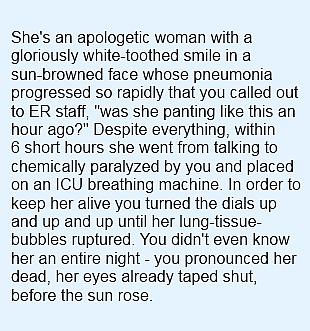
If you were to take a poll, asking why homeless people might die younger and more often, most people, even those in healthcare, would probably say the deaths would be due - directly or indirectly - to mental illness and substance abuse. But with a few exceptions, the studies paint a surprisingly different picture.
In studies conducted in cities as diverse as Boston, New York, and Copenhagen, mental illness was not predictive of death. In many studies, a history of substance use also was not predictive. What was predictive of a markedly higher risk of death was any history of medical illness or disability. As the New York study said, those with a higher risk of death "were more likely to have a disease or injury or handicap, and were more likely to report serious medical conditions such as hypertension, heart problems, cancer, pneumonia, or tuberculosis. Consistent with the Boston findings, neither mental health nor substance abuse problems predicted premature mortality for either the men or the women in the cohort." Acute and chronic medical conditions are more predictive of death than either mental illness or substance use alone - although the combination of all three may dramatically increase the risk of death. In the weeks or months prior to death, studies show that people seek healthcare in ways that vary tremendously, and in patterns that are poorly understood - often with numerous emergency room visits.
Worldwide, it would seem that being too busy trying to survive on the street, and too sick to get consistent help (while trying to survive), can both dramatically increase your chances of dying.
***
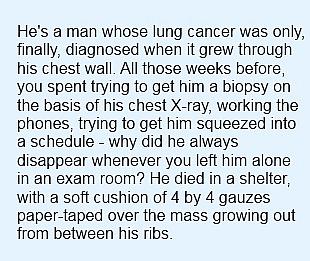
But isn't a higher death rate just a measure of poverty, or some pre-existing damage that led to homelessness? To put it another way, is survival improved, even if you're homeless-level poor and sick, just by having a roof? Two studies from different parts of Scotland tried to tease out this issue. Even if you take a high mortality rate group (like young drug addicts), and match them based on poverty and level of drug use, and every other imaginable characteristic - homelessness alone still dramatically increases the death rate. If you expand that study to other matched groups of people of all types, and compare them to others equally impoverished, the life-saving effect of housing still holds true.
Here in San Francisco, a 2009 study of homeless AIDS patients showed that, of the 6,558 AIDS cases between 1996 and 2006, a whopping 9.8% were homeless at diagnosis. Only 67% of the people who were homeless survived five years, compared with 81% of those who were housed. But if you then housed a homeless person, their survival improved. "Homeless persons with AIDS who obtained supportive housing had a lower risk of death than those who did not (adjusted RH 0.20; 95% CL 0.05, 0.81)."
It would appear that there is something that happens to you when you lose your home - when your life must revolve around trying to survive without a door to lock.
***
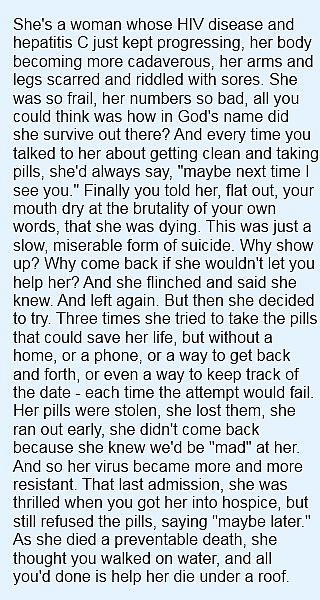
People are thrown into homelessness and some manage to stay aloft. Others don't do well, sometimes early, sometimes late, and those that plummet into severe disease and trauma and crisis are often easier to identify. Others get pulled into the vortex of survival and cannot seem to escape it. Whatever it is that keeps them aloft - moving, striving, struggling out an existence against all odds - that focus may also be what keeps them from escaping the pull and drag of homelessness itself. But that same ceaseless trajectory may also be the thing that kills them.
More and more studies show the marked disparities of health based on geographic location - the cumulative impact of exposures and environmental factors that influence health and behavior and survival, like the 16 years' difference in life purely from living in one East Bay zip code rather than another 12 miles away. But San Francisco, and other urban areas, are more likely to have micro-environments that telescope these extremes until they are side-by-side. There is no more extreme example of life and death disparities than that of dying three decades younger, based purely on whether you live inside, or outside, the same wall in San Francisco.
How does this happen? Does losing your home inevitably mean losing your health? And then, does losing your health when homeless inevitably mean death? Is there something about surviving on the street that changes you - and do those changes prevent you from getting help? What is it really like on the street? Tune in next Tuesday to meet Nathan, and see his photos - pictures he took of what he eats, how he lives, what gives him joy and what scares him.
What can you do?
As you look around your own neighborhood, are you wishing you could just do something to make life a tiny bit easier for the destitute? Here are some practical, non-cash-based ideas - this Saturday, here, the next article will be the 4th Annual Doc Gurley Homeless Gift Guide, for tips on how, instead of striding past a panhandler, you can give a small, practical gift safely and well. And if you can make it this Saturday to Novato at 8am sharp, consider joining an event called Warm Wishes, which comes highly recommended by a big-hearted (and discerning) friend. Or, fire departments are doing a Soap for the Homeless drive (although I would strongly recommend travel size containers, as larger ones are too heavy to carry around), St. Anthony's is doing a sock drive, and Larkin Street is organizing gifts for homeless and runaway youth - whether it's Haiti or here, I personally just find it heartbreaking when a toothbrush, or feminine hygiene products are big items on someone's wish list. And if you have cash, there is, of course, the important Season of Sharing option, as well as excellent agencies (such as St. Anthony's and Larkin Street) whose work will be covered in future articles.
Finally, there's one simple, powerful thing all of us can do. Surveys show that people who are homeless have frequent exposure to, and unique fears about, death and dying. Homeless people anticipate that their end-of-life care will be poor, and also fear "dying anonymously and undiscovered." Mark your calendar to come down to Civic Center on the winter solstice (December 21) for the annual homeless death memorial. Whether you can be there in person, or decide to just take a moment of silence during your day, you can be part of honoring the death of a person who may have deeply feared dying unknown.
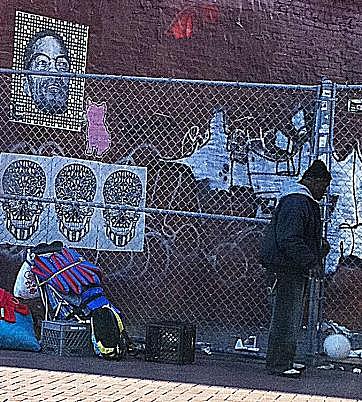
What do YOU think? Share in the comments section and stay tuned for more on The California Endowment Health Journalism Fellowship series of articles by Doc Gurley on homelessness and mortality. There will be an article every Tuesday - find out who's dying in your neighborhood, what's being done about it, and what you can do to help. This article was produced as a project for The California Endowment Health Journalism Fellowships, a program of USC's Annenberg School for Communication & Journalism.
*Identifying traits are changed to protect patient confidentiality, and the accompanying street photos are NOT of patients.
Doc Gurley is a Harvard Medical School graduate and is a practicing board-certified internist, and the creator of the Memoriam app - the first, and only, app to allow disaster-relief workers to speak for the dead. You can follow Doc Gurley on Facebook. You can get more health posts at www.docgurley.com, or jump on the Twitter bandwagon and follow Doc Gurley. Also check out Doc Gurley's joyhabit and iwellth twitter feeds - so you can get topic-specific, effective, affordable tips on how to nurture your joy and grow your personal wellth.

